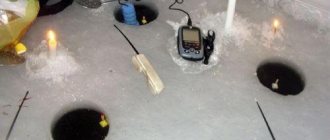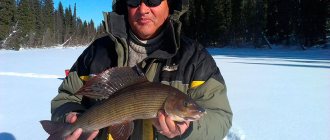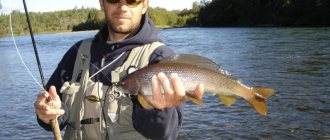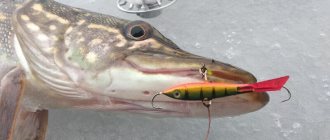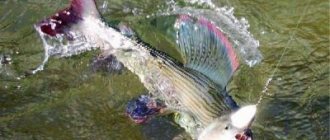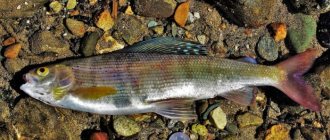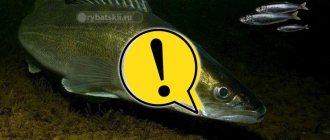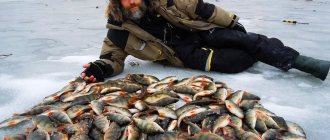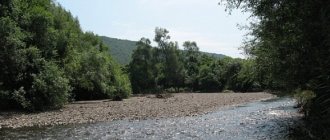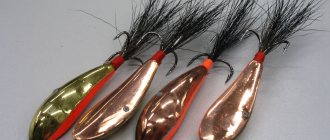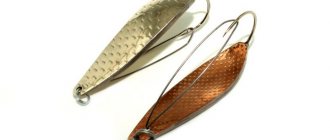Fishing places
First you need to decide where it is most advisable to look for grayling in winter.
Small rivers
It is difficult to find grayling on a small river in winter, especially if it is not there. In other words, when going to a tiny river for grayling, you must be absolutely sure that it stayed there for the winter, and did not slide into a wintering hole in a more comfortable reservoir.
Each small river has its own characteristics: in some places, grayling is caught in winter in the same place as in summer - in front of rapids and riffles (or in barrels behind them), and in others - on clear whirlpools with a weak current. Grayling prefers a rocky or sandy bottom and is almost never caught in silty areas. For successful fishing, you need to notice promising places since the summer, or ask for the company of a local fisherman.
Looking for grayling in winter on an unfamiliar small river is an activity only for the most desperate enthusiasts. It should also be remembered that on most small rivers in winter only small “stream” grayling are caught.
Big rivers
In winter, on large and medium-sized rivers, grayling is caught slightly away from the strong current - on stretches behind the rifts, pebble and gravel banks. In such places, by the end of winter, sometimes no more than 10 cm of water remains under the ice. Traditionally promising places are:
- mouths of rivers and streams,
- slumps and depth changes,
- boundaries of deep gullies and non-freezing rifts.
It’s good if the fisherman knows the exact location of the wintering hole. In this case, grayling needs to be looked for next to it - in winter, it does not make long migrations and feeds not far from the hole.
Lakes
In large lakes with good oxygen conditions, grayling can remain active almost all winter. In grayling lakes you should look for:
- on the upper edges of the pits,
- at the mouths of flowing rivers and streams,
- on rocky shallows (banks) among great depths,
- in the coastal zone with springs gushing at the bottom,
- coastal sandy and rocky shallows with depths of no more than 1.5-2 m.
Description of fish and lifestyle
Grayling is rightfully considered one of the most beautiful freshwater fish, which prefers clean and cool waters. If initially this predator was distributed only in northern mountain streams, then later it was successfully stocked in rivers and lakes of the Volga and Dnieper basins.
Like all salmon fish, grayling prefers fast, cold water. Large fish can grow up to 60-70 centimeters in length, and the weight of individual specimens exceeds 2-3 kilograms. If at an early age grayling mainly feeds on worms and insects, then by 4-5 years of life it becomes a pronounced predator, preferring to hunt small fish.
A characteristic feature of the grayling's appearance is its large dorsal fin, which can shimmer in all the colors of the rainbow. The fish itself has a light olive or silver tint, vaguely reminiscent of freshwater trout in appearance.
Grayling, especially small ones weighing up to 1 kilogram, prefers a schooling lifestyle and stays in riffles and in areas with fast currents. Most often, this fish can be found on rocky shallows, where the current accelerates and then abruptly goes deeper. It has been noted that grayling prefers to stay in the same places in summer and winter. Accordingly, if you identify areas in open water where this predator is often found, then in winter after freeze-up you can successfully catch this fish.
Fishing time
Immediately after freeze-up, as well as on gloomy cloudy days, grayling can sometimes be caught throughout the day, but as the ice thickness increases, the bite is observed only in the morning and (to a lesser extent) in the evening. Traditionally, the best fishing time is an hour just before dawn.
In a number of regions, for example, on Baikal, night winter fishing for grayling is also common. At the same time, as local fishermen assure, a good bite occurs only on moonless nights.
Models of the most catchy jigs for grayling
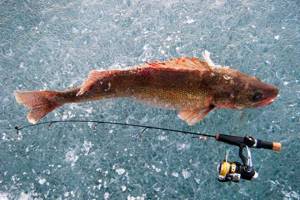
It is difficult to find catchable jigs from an unknown manufacturer. The following brands are considered the most popular among fishermen.
Fishing
- Most jigs are made from tungsten rather than lead, resulting in products that are much lighter and cheaper.
- Fishermen use them to catch cautious fish and save money.
- So a drop with a hole with a diameter of 2.0 mm. and weighing 0.11 g costs about 13 rubles.
- In this case, the production uses hooks of the Hayabusa brand (Japan) and galvanic coating of gold, copper, black, nickel and silver.
- But drops with a diameter of 5-6 mm and a weight of 2.95 g are 3-4 times more expensive.
Lumicom
- This is also a manufacturer of tungsten jigs in a low price category.
- The most popular model is “Female Ant d. 3.0".
- It matches the size of this insect and imitates its behavior as much as possible.
Salmo
- The company produces various fishing accessories and baits.
- The main material for manufactured jigs is tungsten.
- The products are very catchy, but their cost varies between 40-50 rubles per 1 piece.
- Thus, tungsten ones with a faceted ball and loop do not lose strength at the point of attachment, weigh about 0.25 g and, due to their flickering edges, attract prey.
Lucky John
- The company has been producing winter and summer jigs for over 30 years.
- The high quality of the products is what fishermen love.
- The “Lucky John 20-s” jig is a Latvian-made devil weighing up to ¼ g and with hooks No. 18, having a triangular shape and a loop.
- Price – up to 140 rub.
- If you need a set of 10 pieces of large jigs for 250 rubles, you should pay attention to the model “LJ13050-139”. This is a tungsten product coated with a polymer composition with a diameter of 5 mm. and weighing 1.3 g. The jig is strong and durable.
Sava
- The most common model of this.
- It is a classic example of this class.
- It has a hole with a diameter of one and a half millimeters.
- The product is sold in sets of 10 pieces at a price of about 340 rubles.
Disguise
Grayling is not afraid of the noise of a working ice auger, but you should not clear the hole of slush by repeatedly lowering and raising the auger in the drilled hole. As when catching perch, it is better not to remove ice chips from the hole at all, but to make a hole in it with a stick and lower the bait into the resulting hole.
This is also done in order not to expose the hole to light, although a number of anglers claim that grayling are not afraid of light. In any case, the angler’s movements on the ice will not go unnoticed by him, and large sharp grayling will not approach such a hole.
On the first clear ice, especially in shallow places, some anglers successfully catch grayling “closely”, shading the hole with a tent or blanket.
Search tactics
It is well known that the number of fish caught in winter is directly proportional to the number of holes drilled. Grayling in this sense is no exception. You need to drill often and a lot, but not randomly.
Grayling, as a rule, stands in one place and is extremely reluctant to leave it, so you will have to drill test holes in one line from the shore to the depth, retreating several meters to the side, as if in a checkerboard pattern.
The purpose of such drilling is to find relatively quiet places near the stream, as well as depth differences. If you have an echo sounder or an underwater camera, you can immediately determine the presence of fish, as well as the location of large boulders and snags, behind which grayling likes to stand, sheltering from strong currents.
On small rivers, as mentioned above, it is advisable to at least approximately know the depths and relief, so as not to plant the ice auger knives into the bottom already on the first hole. However, the presence of a fast current on a small river is noticeable even in winter, and it is next to it that you can safely begin your search.
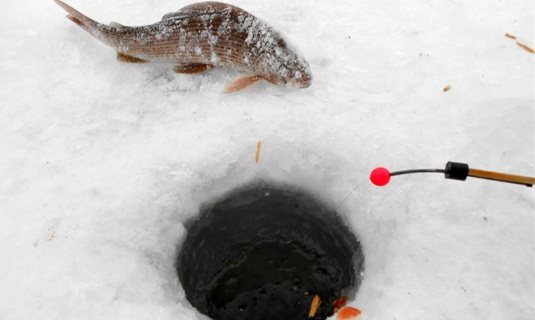
If there is a beaver dam on the river, then you need to look for grayling immediately behind it. On small rivers, holes are drilled very close - it happens that grayling takes in one hole, but not literally half a meter away.
Usually, if there is grayling and it is active, then the bites begin immediately after the hole is drilled. If there are no bites on different types of bait, you should not stay in one place for a long time. The tactic of “hatching” and “knocking out” fish from under the ice with grayling does not work. Fishing for grayling in winter is all about movement and search.
In many reservoirs, it happens that grayling takes well only on the first and last ice, and the rest of the time it rarely leaves its wintering hole. Therefore, it is important to know well the habits of grayling in each specific reservoir, so as not to waste precious winter time.
Where can you find grayling in winter?
Shortly before the first ice forms, grayling actively prepares for winter. This is expressed in a radical change from favorite summer sites to winter ones. Like the vast majority of freshwater fish, grayling inhabit various channel depressions, whirlpools and flow-through holes. If there are beaver ponds on a small river, you can find a school of fish there in winter.
In some cases, the fish move downstream, going into large rivers or even ponds. But some of this species will certainly remain to spend the winter, even in rivers with an average depth of only half a meter or a meter. The so-called brook grayling remains to spend the winter in micro-rivers. It is distinguished by its slightly smaller size and settled character. Small fish live in one place almost all year round, being content in winter with the meager food brought by the current.
Lack of food, constant movement in the current and oxygen-enriched water force the fish to feed even in the dead of winter.
Tackle
Mormyshka
In winter, grayling, like most of our fish, is most often caught using a jig. The equipment as a whole differs little from perch equipment.
- An ordinary balalaika is quite suitable as a fishing rod.
- The nod is preferably hard and powerful; the material is not of fundamental importance.
As for the thickness of the fishing line, it all depends on the size of the grayling in your river. Of course, even small grayling is a very strong fish, but in most cases a high-quality fishing line with a diameter of 0.12-0.14mm is quite sufficient.
Of course, if the catches are dominated by grayling weighing a kilogram or more, the line diameter can be 0.18 or 0.20 mm. But most fishermen can only dream of such trophies.
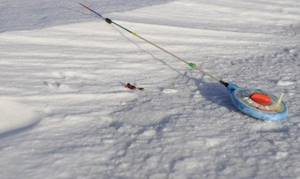
Mormyshki use both attachments and nozzles. They are selected by sampling based on local conditions. The main thing is to choose the right size and weight of the jig according to the strength of the current.
When the bite is sluggish, small tungsten jigs are used. There are no universal “grayling” jigs; more often than not, this is just a marketing ploy. Everyone knows that jigs that imitate caddisfly and dragonfly larvae are great for catching other fish.
You should also try the most common jigs:
- Uralki,
- pellets,
- oatmeal,
- droplets
The same goes for choosing colors. In a word, everything is almost like when fishing for perch. Sometimes grayling can be caught well with pike perch-type jigs, only smaller in size. In unfamiliar places, you can try to find out what the local aborigines use to catch grayling - this is the most effective, although not the most sporting, method.
Front sight
Grayling is caught in winter using both summer fly flies and special winter flies. A separate story is nymphs and fly jigs, which are a hybrid of a jig and an artificial fly.
Previously, all this was done by hand, but today excellent winter flies are sold in any fishing store:
- "shitik"
- "maggot"
- "caddis fly"
- "three-color"
In the literature, there is often a recommendation to catch European grayling with bright fancy flies, and Siberian grayling with gray and inconspicuous flies. In practice, this statement is not confirmed at all. But it is a fact that grayling is not indifferent to any trout fly.
Most often, a light fly is mounted in tandem with a jig. The fly (and sometimes a whole garland of them) is tied above the jig. This is a very effective method, which has only one drawback - when fishing, the top fly often clings to the edge of the ice. This can be partially avoided by tying the fly not to the leash, but to the main line.
Retractable leash
The retractable leash allows you to fish with light jigs, flies and nymphs in strong currents. The design of this gear is simple
- A sinker is attached to the end of the line, and above – usually 10-15 cm – a lead is tied with a jig or fly.
- The weight of the sinker is selected depending on the strength of the current - it should not be carried away.
Fishing with a retractable leash requires a certain skill - the wiring must be thin and delicate so that the bait, and not the sinker, actively plays. Sometimes a heavy jig is used instead of a sinker, and a Tyrolean stick is used in snags.
Spoon
In some places, large grayling take bait well. For grayling, both classic winter spinners like “clove” or “smelt” and spinners like “Nils Master” are suitable.

The size of the spoon for small grayling is 2-3 cm, for large grayling - 3-5 cm. Either natural bait or cambric, a silicone worm or a fry (silicone can also be used) is placed on the hook of the spoon. The shank of the hook is often wrapped with thread or lurex.
Zherlitsa
Ladoga fishermen can best tell you how to catch grayling in winter using girders. In principle, a girder for grayling is the same as a pike girder, only smaller.
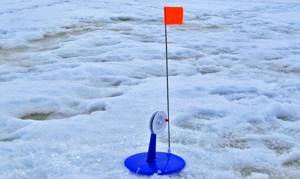
A metal leash for grayling is not needed; the smallest tee is chosen, sometimes it is replaced with a double or single hook. The best live bait for grayling is a minnow. Often, instead of a traditional fishing rod with a flag, they simply use a powerful winter fishing rod.
Best tackle
For winter grayling fishing, it is preferable to use small fishing rods that have a long nod with a large amplitude. The thickness of the fishing line should be chosen as thin and inconspicuous as possible. Many experienced fishermen catch large grayling on fishing poles, using frozen chafer larvae, various artificial insects or small live bait as bait.
On large rivers that do not freeze even in winter due to strong currents, successful catching of this fish with summer gear is possible. Both various fishing rods 5 meters long or more, as well as spinning rods for guiding flies or small wobblers, can be used. You should look for grayling in winter in places where water is discharged, on riffles and any small unfrozen areas.
In winter, catching this fish is done using various artificial flies, as well as wobblers that imitate all kinds of insects. Grayling is an extremely cautious and timid fish, so you need to select thin tackle, securing the sinker as far as possible from the hook so that it does not fall into the field of view of this fish.
Choosing bait and bait
Grayling is unpretentious in its food preferences. It bites well on crawling or worms, bloodworms, bark beetle larvae, and various artificial insects. Catching this fish with a minnow also shows excellent results, which allows you to be guaranteed to catch the largest specimens.
The only thing this predator does not like is various plant baits: all kinds of cereals, boilies and similar baits. Therefore, when going fishing, you should first take care of the presence of a worm, bloodworms or small baitfish.
Fishing with all kinds of jigs is extremely catchy . It is best to give preference to the following jigs for grayling in winter:
- Imitation insects.
- Jigs with red and brown threads.
- Extra heavy jigs with maggot or burdock.
At the depth where the largest grayling is found, the fish can ignore animal baits, but will never miss a small light-colored spoon. Spinnering must be done with an amplitude of no more than a meter at an average pace, giving preference to spinners that imitate small fish. You can also use all kinds of jig heads and soft spinning baits. Spinning tackle shows good results when fishing in fast currents.
Fishing in winter with a jig
This tackle is distinguished by its versatility of use; it is effective both for catching small specimens weighing 500 grams and will allow you to catch large fish weighing 2-3 kilograms.
Preference should be given to large tungsten jigs weighing one and a half to two grams. It would not be superfluous to tie another hook approximately 15 centimeters above the jig, the tip of which is directed downwards.
Of the attachments, the best results are shown by the following:
- Burdock larvae.
- Maggot.
- Worms.
- Pieces of fresh fish.
The game of the jig should be smooth and slow. Try to fish both in greater depth and in the rifts, where the strongest current is observed.
Excellent results are shown by fishing with baitless jigs that are golden or silver in color. When using such baitless jigs, the fishing technique will be as follows:
- The tackle slowly sinks to the bottom.
- They sharply jerk and lift the bait 10-20 centimeters from the bottom.
- Allow the jig to fall to the ground, after which the fishing rod is sharply twitched again.
This playing technique is extremely effective when catching these wary fish, which will greedily peck at such an original jig game.
Lures
For winter fishing for grayling, mainly only animal baits are used:
- bloodworm,
- caddisfly,
- maggot,
- mormysha,
- bark beetle,
- burdock,
- worm.
The choice of bait depends on the tastes of grayling in each particular reservoir. As you know, he most readily bites on the bait that is his main food in a given body of water. However, many experts successfully catch grayling in winter using a reelless bait, without bothering with the painful question of choosing bait.
Tackle for catching grayling in winter using a jig
To catch grayling, use the following gear:
- hook;
- fishing line;
- nod;
- nozzle.
Note! Each of them should be studied in more detail.
Nod
To catch grayling, purchase a long and rigid product with a maximum oscillatory amplitude. He must quickly signal that the bite has begun.
fishing line
Its width can affect the entire catch, not just grayling. First of all, this is due to its use in clear water conditions - in it, a thick fishing line is easily distinguished by fish.
Therefore, fishing line with a diameter of up to 0.12 mm is used to equip gear. You can catch fish up to one and a half kg with it. For fishing in a river, you can use a fishing line with a diameter of up to 0.14 mm.
Hook
For the convenience of winding wool or thread, fishermen purchase hooks with long shanks. The size of the hook depends on the size of the prey being caught. Most anglers prefer products No. 3-6.
Nozzle
If you use live bait, then:
- caddisfly larvae;
- bloodworm;
- burdock.
Let's celebrate! A jig is a non-living bait that perfectly imitates a living one.
Lure
Used quite rarely. Effective feeding of grayling is only possible when using stationary feeders. There is no point in simply pouring bait into the hole - it will immediately be carried away by the current (unless you are fishing on a lake).
Most often, the bait is lowered to the bottom in a mesh bag in a separate hole upstream. The following are used as bait:
- feed bloodworm,
- chopped worms,
- cottage cheese.
In Siberia, they are most often fed with mormysh - fresh or boiled. The purpose of bait is not to feed the fish, but only to try to attract it to your holes.
Search for a promising location
So, let us immediately note that grayling is found only in reservoirs with clean water; it does not like areas with a bottom overgrown with grass or covered with moss. You can find grayling in winter in pools with clear and clean water with a rocky, sandy, pebble or rocky bottom.
In winter, grayling is often found in pits, can be found behind large stones, and under favorable weather conditions it comes out to feed in the reaches. In rivers, it tries to stay in areas with a flat bottom and a moderate current, when unfrozen riffles appear, grayling can be found at the edge of the ice.
However, not every pool will contain grayling; to find the fish you will need:
- two holes are drilled at the entrance to the pool, three in the middle, two at the exit. The distance between the holes is 30-50 cm.
- You should fish in each hole for 2-3 minutes; you need to start exploring the selected pool from the hole that was completed first. If there are no bites, this indicates the absence of fish in the selected area.
- If during the fishing process you managed to catch several fish, then you need to return to this pool in the evening, closer to sunset.
IMPORTANT! You need to drill holes at the border of depressions and holes, as well as next to the stream flow - these are the most promising areas for fishing in winter, where active grayling is found.
Fishing tactics
- At the beginning of fishing, they try to determine what the grayling is taking, and whether it is taking at all. To do this, they methodically fish all promising places, trying both different baits and different retrieve rates.
- Usually they start catching grayling by raising the jig from the bottom by 5-10 cm. If this doesn’t work, they start fishing all the way down to the ice.
- Sometimes, especially in the middle of winter, grayling takes well on a stationary jig. True, a prerequisite for this is the presence of fresh bait on the hook. The jig needs to be moved periodically.
- If the bottom is rocky, you need to periodically tap it with a jig - grayling responds well to sound.
- You should always try to fish in a freshly drilled hole. If there are no bites right away, you must return to the hole a little later.
- The usual pace of fishing when fishing for grayling is smoother and slower than when fishing for perch, but somewhat more intense than when fishing for bream.
- If there are no bites, you should not stay on one hole for more than 8-10 minutes.
- In case of sluggish bite and empty bites, you should change the jig or fly to a smaller one.
- Grayling is a very fast fish, you need to hook it quickly and strongly, and fish it out confidently and without fuss, without giving the fish even an inch of slack.
Catching grayling in winter is not an easy task. But failed, fruitless fishing trips should not upset a real fisherman. We must continue to find our way to this king fish. And then - sooner or later - you will certainly be rewarded with a rich catch.
Habits of winter grayling
In general, even though grayling occupies deep holes in winter, a current must pass through them. Thus, fish that are sedentary in cold water simply wait for food brought by the river in a comfortable place. The fisherman’s task is to find these sites and select the appropriate gear.
Important . Such places are relatively easy to spot with the help of polarized glasses in clear autumn water. At the first small night frosts, the fish occupy them.
In winter, active biting for grayling most often occurs in the morning, a little worse in the evening. During the day, it can be quite difficult to move the fish. The only exception is the beginning of winter and thaw with cloudy weather.
Recommended reading: Carp fish
It has been noticed that in the morning the best bite occurs near the rifts, at a relatively shallow depth. It is better to try fishing in deeper and calmer places in the evening.
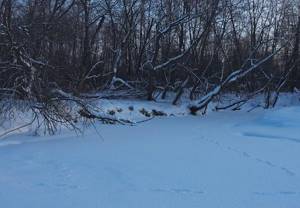
It is believed that grayling is not a timid fish, but it is clearly not worth stomping on the ice and talking loudly. Especially if the depth under the ice is one to one and a half meters.
You need to approach the holes even more responsibly. A bright beam of light penetrating through a hole in the ice can alert fish. It is better to immediately powder the drilled holes with soft snow, leaving a hole literally as thick as a finger.
